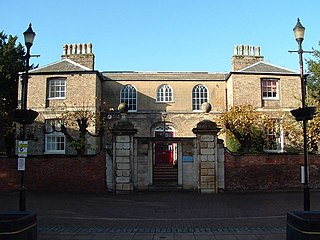The Blessed John Adams was an English Catholic priest and martyr.
Thomas Worthington, D.D. was an English Catholic priest and third President of Douai College.
The Douai Martyrs is a name applied by the Roman Catholic Church to 158 Catholic priests trained in the English College at Douai, France, who were executed by the English state between 1577 and 1680.
Maurus Scott, born William Scott, was an English lawyer who became a Benedictine monk and priest, serving as a missionary in England during the period of recusancy. He was executed at Tyburn, and is a Catholic martyr.
Richard Blount, S.J. (1565–1638) was an English priest and the first Jesuit Provincial of England after the Elizabethan Laws were passed.
Blessed Edward James was an English Catholic priest and martyr.
A priest hunter was a person who, acting on behalf of the British government, spied on or captured Catholic priests during Penal Times.

The Eighty-five Martyrs of England and Wales, also known as George Hatdock and Forty-one Companion Martyrs, are a group of men who were executed on charges of treason and related offences in the Kingdom of England between 1584 and 1679. Of the eighty-five, seventy-five were executed under Jesuits, etc. Act 1584.
Edward Waterson was an English Catholic priest and martyr. He served the hidden Catholics in England during the reign of Elizabeth I. Edward was arrested in 1593 and executed at Newcastle upon Tyne. He was beatified in 1929.
Robert Nutter was an English Catholic priest, Dominican friar and martyr. He was beatified in 1987.
Thomas Pormort was an English Roman Catholic priest. He was beatified in 1987.
Blessed Thomas Belson was an English Roman Catholic layman. He is a Catholic martyr, beatified in 1987.
William Harrington was an English Jesuit priest. He is a Roman Catholic martyr, beatified in 1929.
George Haydock was an English Roman Catholic priest. He is a Catholic martyr, beatified in 1987. He is not to be confused with his relative, also a priest, George Leo Haydock (1774–1849).
James Fenn was an English Roman Catholic priest and martyr who was beatified on 15 December 1929, by Pope Pius XI. He was the brother of the Roman Catholic priest and writer John Fenn and also had another brother named Robert Fenn. All three brothers were choristers and scholars. Before becoming a priest at around the age of 40, Fenn married and fathered a son and daughter and became a widower. He was executed for his loyalty to the Roman Catholic faith, which was contrary to the demand to recognize supremacy of the Church of England in preference to the Church of Rome.
Thomas Tichborne was an English Roman Catholic priest. He is a Catholic martyr.
John Sugar or Suker was an English Roman Catholic priest. He is a Catholic martyr, beatified in 1987.
Nicholas Woodfen born Nicholas Wheeler, also known as Nicholas Devereux, was an English Roman Catholic priest who was hanged, drawn and quartered at Tyburn, London on 21 January 1586. He is considered a Catholic martyr and one of the Eighty-five martyrs of England and Wales who were executed between 1584 and 1679. He was beatified on 22 November 1987 by Pope John Paul II.









